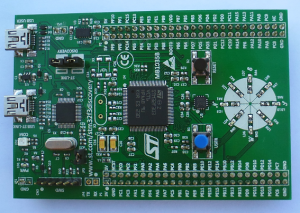If you have ever wanted to experiment with an RISC microcontroller that comes with special Digital Signal Processing (DSP) capability, the STM32F3DISCOVERY board might just be the right board for you to start with. STMicroelectronics shipped out a board to me for review. Let’s have a look!
The STM32 F3 series of microcontrollers are based on the 32-bit ARM Cortex-M4 core, which has Digital Signal Processor (DSP) extensions and a Floating-Point Unit (FPU). The STM32F3DISCOVERY board comes with an STM32F303VCT6 [1] microcontroller featuring 256 KB Flash, 48 KB RAM in an LQFP100 package [2].
- STM32F303VCT6, ST’s ARM® Cortex™-M4F based MCU with:
- 256 KB Flash
- 48 KB SRAM
- Maximum CPU Frequency: 72 MHz
- Real Time Clock (RTC)
- 2 x Watchdog
- 9 x 16-bit Timer
- 1 x 32-bit Timer
- 4 x 12-bit ADC (39 channels)
- 2 x 12-bit DAC
- 88 GPIOs
- 3 x SPI
- 2 x I2C
- 5 x USART
- USB
- CAN
- Supply Voltage: 2 – 3.6 V
- L3GD20, ST MEMS motion sensor, 3-axis digital output gyroscope
- LSM303DLHC, ST MEMS system-in-package featuring a 3D digital linear acceleration
sensor and a 3D digital magnetic sensor. - Flexible power supply options
- Power from either on-board USB connector
- External 3 V or 5 V supply
- On-board ST-LINK/V2
- Reset button
- One user push-button and 8 user LEDs
- 100 mil (2.54 mm) expansion headers
Due to the kind of sensors the board offers and the DSP functionality of the MCU, the board is perfect for navigational experiments. The board offers plenty of horsepower to be used in autonomous Unmanned Aerial Vehicles (UAVs) such as Quadcopters and RC planes.
The board looks very organized and cleanly routed. There are two USB-port. One for the user application and one for the ST-LINK/V2 debugger. ST did leave an unpopulated spot for an external crystal for applications which require greater accuracy / precision.
What I particularly like is the 100 mil / 2.54 mm header on the bottom of the board. This header makes it easy to use breadboard style setups for experiments.
The default firmware features 3 small sample applications. On power-up, the 8 user LEDs will start lighting in a circular motion. If the user button is pressed, the LEDs will now indicate the direction of acceleration. If the button is pressed again, the 8 LEDs will act as a compass and indicate the direction to magnetic north.
Here’s a short video of the first demo application. Sorry for the poor video quality.
The board is available for $10.88 from Newark [3].
Links and Sources:
[1] ST 32 F302-series MCUs, STM: http://www.st.com/
[2] STM32F3DISCOVERY User Manual, STM: http://www.st.com/
[3] STM32F3DISCOVERY User Manual, STM: http://www.newark.com/
Westerhold, S. (2012), "Review: STM32 F3-series Discovery Kit". Baltic Lab High Frequency Projects Blog. ISSN (Online): 2751-8140., https://baltic-lab.com/2012/11/review-stm32-f3-series-discovery-kit/, (accessed: June 30, 2025).
- WebP-Images without Plugin - January 14, 2025
- Firewall Rules with (dynamic) DNS Hostname - January 14, 2025
- Restoring proxied visitor IPs from Cloudflare - December 26, 2024

